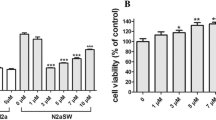Abstract
Betaine was an endogenous catabolite of choline, which could be isolated from vegetables and marine products. Betaine could promote the metabolism of homocysteine in healthy subjects and was used for hyperlipidemia, coronary atherosclerosis, and fatty liver in clinic. Recent findings shown that Betaine rescued neuronal damage due to homocysteine induced Alzheimer’s disease (AD) like pathological cascade, including tau hyperphosphorylation and amyloid-β (Aβ) deposition. Aβ was derived from amyloid precursor protein (APP) processing, and was a triggering factor for AD pathological onset. Here, we demonstrated that Betaine reduced Aβ levels by altering APP processing in N2a cells stably expressing Swedish mutant of APP. Betaine increased α-secretase activity, but decreased β-secretase activity. Our data indicate that Betaine might play a protective role in Aβ production.





Similar content being viewed by others
References
Honjo K, Black SE, Verhoeff NP (2012) Alzheimer’s disease, cerebrovascular disease, and the beta-amyloid cascade. Can J Neurol Sci 39(6):712–728
Singh S, Kushwah AS, Singh R, Farswan M, Kaur R (2012) Current therapeutic strategy in Alzheimer’s disease. Eur Rev Med Pharmacol Sci 16(12):1651–1664
Lane RF, Shineman DW, Steele JW, Lee LB, Fillit HM (2012) Beyond amyloid: the future of therapeutics for Alzheimer’s disease. Adv Pharmacol 64:213–271. doi:10.1016/B978-0-12-394816-8.00007-6
Takahashi RH, Capetillo-Zarate E, Lin MT, Milner TA, Gouras GK (2013) Accumulation of intraneuronal beta-amyloid 42 peptides is associated with early changes in microtubule-associated protein 2 in neurites and synapses. PLoS One 8(1):e51965. doi:10.1371/journal.pone.0051965
Seward ME, Swanson E, Norambuena A, Reimann A, Cochran JN, Li R, Roberson ED, Bloom GS (2013) Amyloid-beta signals through tau to drive ectopic neuronal cell cycle re-entry in Alzheimer’s disease. J Cell Sci. doi:10.1242/jcs.1125880
St George-Hyslop P, Fraser PE (2012) Assembly of the presenilin gamma-/epsilon-secretase complex. J Neurochem 120(Suppl 1):84–88. doi:10.1111/j.1471-4159.2011.07505.x
Wolfe MS (2012) gamma-Secretase as a target for Alzheimer’s disease. Adv Pharmacol 64:127–153. doi:10.1016/B978-0-12-394816-8.00004-0
Ly PT, Wu Y, Zou H, Wang R, Zhou W, Kinoshita A, Zhang M, Yang Y, Cai F, Woodgett J, Song W (2013) Inhibition of GSK3beta-mediated BACE1 expression reduces Alzheimer-associated phenotypes. J Clin Invest 123(1):224–235. doi:10.1172/JCI64516
Jeppsson F, Eketjall S, Janson J, Karlstrom S, Gustavsson S, Olsson LL, Radesater AC, Ploeger B, Cebers G, Kolmodin K, Swahn BM, von Berg S, Bueters T, Falting J (2012) Discovery of AZD3839, a potent and selective BACE1 inhibitor clinical candidate for the treatment of Alzheimer disease. J Biol Chem 287(49):41245–41257. doi:10.1074/jbc.M112.409110
Zeisel SH, Mar MH, Howe JC, Holden JM (2003) Concentrations of choline-containing compounds and betaine in common foods. J Nutr 133(5):1302–1307
Hooshmand B, Solomon A, Kareholt I, Leiviska J, Rusanen M, Ahtiluoto S, Winblad B, Laatikainen T, Soininen H, Kivipelto M (2010) Homocysteine and holotranscobalamin and the risk of Alzheimer disease: a longitudinal study. Neurology 75(16):1408–1414. doi:10.1212/WNL.0b013e3181f8816275/16/1408
Kharbanda KK, Mailliard ME, Baldwin CR, Beckenhauer HC, Sorrell MF, Tuma DJ (2007) Betaine attenuates alcoholic steatosis by restoring phosphatidylcholine generation via the phosphatidylethanolamine methyltransferase pathway. J Hepatol 46(2):314–321. doi:10.1016/j.jhep.2006.08.024
Chai GS, Jiang X, Ni ZF, Ma ZW, Xie AJ, Cheng XS, Wang Q, Wang JZ, Liu GP (2013) Betaine attenuates Alzheimer-like pathological changes and memory deficits induced by homocysteine. J Neurochem 124(3):388–396. doi:10.1111/jnc.12094
Liu XP, Zheng HY, Qu M, Zhang Y, Cao FY, Wang Q, Ke D, Liu GP, Wang JZ (2012) Upregulation of astrocytes protein phosphatase-2A stimulates astrocytes migration via inhibiting p38 MAPK in tg2576 mice. Glia 60(9):1279–1288. doi:10.1002/glia.22347
Lu YQ, Luo Y, He ZF, Chen J, Yan BL, Wang Y, Yu Q (2013) Hydroxysafflor Yellow A ameliorates homocysteine induced Alzheimer-like pathologic dysfunction and memory/synaptic disorder. Rejuvenation Res. doi:10.1089/rej.2013.1451
Boldyrev AA, Johnson P (2007) Homocysteine and its derivatives as possible modulators of neuronal and non-neuronal cell glutamate receptors in Alzheimer’s disease. J Alzheimers Dis 11(2):219–228
Van Dam F, Van Gool WA (2009) Hyperhomocysteinemia and Alzheimer’s disease: a systematic review. Arch Gerontol Geriatr 48(3):425–430. doi:10.1016/j.archger.2008.03.009
Clarke R, Smith AD, Jobst KA, Refsum H, Sutton L, Ueland PM (1998) Folate, vitamin B12, and serum total homocysteine levels in confirmed Alzheimer disease. Arch Neurol 55(11):1449–1455
Zhang C (2012) Natural compounds that modulate BACE1-processing of amyloid-beta precursor protein in Alzheimer’s disease. Discov Med 14(76):189–197
Ferretti MT, Allard S, Partridge V, Ducatenzeiler A, Cuello AC (2012) Minocycline corrects early, pre-plaque neuroinflammation and inhibits BACE-1 in a transgenic model of Alzheimer’s disease-like amyloid pathology. J Neuroinflammation 9:62. doi:10.1186/1742-2094-9-62
Acknowledgments
This work was supported in part by the National Natural Science Foundation of China (31300932).
Author information
Authors and Affiliations
Corresponding authors
Rights and permissions
About this article
Cite this article
Liu, XP., Qian, X., Xie, Y. et al. Betaine suppressed Aβ generation by altering amyloid precursor protein processing. Neurol Sci 35, 1009–1013 (2014). https://doi.org/10.1007/s10072-014-1630-y
Received:
Accepted:
Published:
Issue Date:
DOI: https://doi.org/10.1007/s10072-014-1630-y




